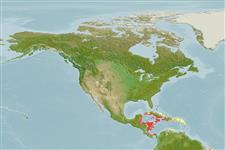>
Blenniiformes (Blennies) >
Chaenopsidae (Pike-, tube- and flagblennies)
Etymology: Emblemariopsis: Latin, emblema = insertion, inlaid work, raised ornament + Greek, opsis = appearance (Ref. 45335).
Eponymy: George Cadle Price (1919–2011) was the premier of Belize (1961–1984 & 1989–1993). [...] (Ref. 128868), visit book page.
More on author: Greenfield.
Environment: milieu / climate zone / пределы глубины / distribution range
экология
морской ассоциированный с рифами; немигрирующий; пределы глубины 1 - 30 m (Ref. 51514). Tropical
Western Atlantic: Belize and Honduras.
Length at first maturity / Size / Вес / Возраст
половая зрелость: Lm 1.8, range 2 - 1.92 cm
Max length : 2.9 cm SL самец/пол неопределен; (Ref. 51514); 2.0 cm SL (female)
колючие лучи спинного плавника (общее число) : 20; членистые (мягкие) лучи спинного плавника (общее число) : 12 - 14; колючие лучи анального плавника: 2; членистые (мягкие) лучи анального плавника: 21 - 23. This species with no orbital cirrus or a red banner is distinguished by the following characters: TP territorial males found in holes with a black head; the anterior dorsal fin plain black without a white rim, sometimes irregular grainy white patches; the first dorsal-fin spine very short, when adpressed extending posteriorly to about 5th spine base, about 1/4 HL, and subsequent spines rising to midfin spines; sometimes with an irregular row of dark spots along proximal membranes of spinous dorsal fin; occasionally with a short row of small dark spots along anterior lateral midline (Ref. 125603).
Dark-shaded, pale, and transitional TP with very short first dorsal-fin spine, when adpressed reaching to 4th spine base, subsequent spines rising to midfin; usually large irregular grainy white patches on dorsal fin, anterior body, and pectoral fins; usually with an irregular row of dark spots along proximal spinous-dorsal-fin membranes, often indistinct; sometimes with a short row of small dark spots along anterior lateral midline; opercular bands or lines absent; reduced head markings with a dark band from eye across the jaws, a moustache band at rim above maxilla (from a single spot to a thick curve under eye), and typically with an obvious discrete black spot (or small collection) just behind mid-orbit (Ref. 125603).
IP with very short first dorsal-fin spines, when adpressed the first spine reaching to base of 4th-5th spine base, spines rising sharply to midfin spines. Colouration: live colors red, orange, and pink; cranial pattern a Y-shape: an oval band 1, band 2 a prominent Y with pale arms and a red stalk, with a reduced band 3 of one or two isolated spots or segments, a long pale band 4 becoming red towards midline, and band 5 inconspicuous; IP head spots are reduced, typically only a band from eye across jaws and a spot at corner of jaw, one under the jaw; melanophores near pectoral-fin base diffuse, sometimes one or two spots (Ref. 125603).
Cross section: oval.
Found on surface of hard corals and sea fans on coral reefs, from shallow reef crests to drop offs at depths to 30 m. Exhibit greater habitat specificity than other chaenopsids. Spirobranchus giganteus. Females and immature males move about on surface of or near live corals, particularly sea fans. Breeding males are particularly found only in tubes abandoned by serpulid worms Spirobranchus giganteus. These probably controls their population size (Ref. 51514).
Females lay eggs in tube cavities occupied by breeding males (Ref. 51514).
Victor, B.C., 2020. Review of the glass blennies (Teleostei: Chaenopsidae: Emblemariopsis) with two new species from the Caribbean Sea. J. Ocean Sci. Found. 37:1-122. (Ref. 125603)
Статус Красного Списка МСОП (Ref. 130435: Version 2025-1)
Угроза для людей
Harmless
Использование человеком
дополнительная информация
инструменты
Специальные отчеты
Скачать в формате XML
ресурсы в Интернет
Estimates based on models
Preferred temperature (ссылка
123201): 27.3 - 28.3, mean 27.9 °C (based on 139 cells).
Phylogenetic diversity index (ссылка
82804): PD
50 = 0.5001 [Uniqueness, from 0.5 = low to 2.0 = high].
Bayesian length-weight: a=0.00525 (0.00219 - 0.01260), b=3.06 (2.85 - 3.27), in cm total length, based on LWR estimates for this (Sub)family-body shape (Ref.
93245).
Trophic level (ссылка
69278): 3.2 ±0.5 se; based on size and trophs of closest relatives
устойчивость к внешним воздействиям (ссылка
120179): низкий, минимальное время удвоения популяции 4.5-14 лет (Fec = 21).
Fishing Vulnerability (Ref.
59153): Low vulnerability (10 of 100).
🛈
